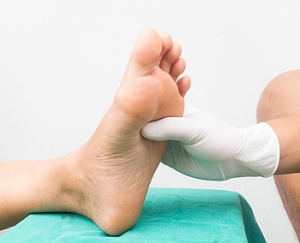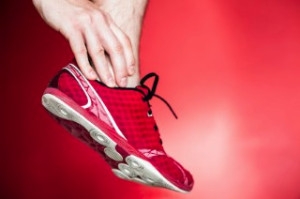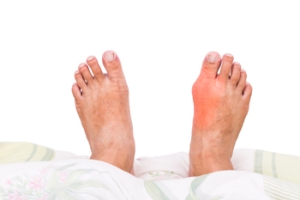
What Are the Signs and Symptoms of Rheumatoid Arthritis?
 Rheumatoid arthritis or RA, is an autoimmune condition that can affect joints throughout the body. It often affects the joints of the feet and ankles. The most common joints in the feet and ankles affected by RA are the smaller joints of the toes, the joints of the forefoot, the subtalar joint between the two tarsal bones of the foot, and less commonly the ankle joint. Signs of RA in your feet include soreness, warmth and swelling of one or more joints that lasts for several days, joint erosion, joint instability, and pain. RA could also cause painful fluid-filled sacs or nodules to develop on the feet. For more information on the signs and symptoms of RA in the feet and what you can do to treat this condition, speak with a podiatrist today.
Rheumatoid arthritis or RA, is an autoimmune condition that can affect joints throughout the body. It often affects the joints of the feet and ankles. The most common joints in the feet and ankles affected by RA are the smaller joints of the toes, the joints of the forefoot, the subtalar joint between the two tarsal bones of the foot, and less commonly the ankle joint. Signs of RA in your feet include soreness, warmth and swelling of one or more joints that lasts for several days, joint erosion, joint instability, and pain. RA could also cause painful fluid-filled sacs or nodules to develop on the feet. For more information on the signs and symptoms of RA in the feet and what you can do to treat this condition, speak with a podiatrist today.
Arthritis can be a difficult condition to live with. If you are seeking treatment, contact one of our podiatrists from Pennsylvania. Our doctors can provide the care you need to keep you pain-free and on your feet.
Arthritic Foot Care
Arthritis is a joint disorder that involves the inflammation of different joints in your body, such as those in your feet. Arthritis is often caused by a degenerative joint disease and causes mild to severe pain in all affected areas. In addition to this, swelling and stiffness in the affected joints can also be a common symptom of arthritis.
In many cases, wearing ill-fitting shoes can worsen the effects and pain of arthritis. Wearing shoes that have a lower heel and extra room can help your feet feel more comfortable. In cases of rheumatoid arthritis, the arch in your foot may become problematic. Buying shoes with proper arch support that contour to your feet can help immensely.
Alleviating Arthritic Pain
- Exercises that stretch the foot can prevent further pain and injury and increase mobility
- Most of the pain can be alleviated with anti-inflammatory drugs, heat, and topical medications
- Massages can help temporarily alleviate pain.
It is best to see your doctor for the treatment that is right for your needs and symptoms. Conditions vary, and a podiatrist can help you determine the right method of care for your feet.
If you have any questions, please feel free to contact one of our offices located in Plymouth Meeting and Ambler, PA . We offer the newest diagnostic tools and technology to treat your foot and ankle needs.
Arthritic Foot Care
During your lifetime, you will probably walk about 75,000 miles, which is quite a lot of stress to put on your feet. As you get older, the 26 bones and 30 joints in each of your feet will lose flexibility and elasticity. Your foot’s natural shock absorbers will wear down as well. Having arthritis added to this mix only makes matters worse. Your joints will become distorted and inflamed, which is why arthritic foot care needs to be something to think about every day.
When dealing with arthritis, having additional foot complications, such as bunions, hammertoes, or neuroma, can be a serious detriment. To avoid these, buy well-fitting shoes with a lower heel and good support. Arthritis causes you to lose your arch, so having shoes with good arch support is also highly recommended.
Aside from getting good arch support, the shoes need to fit comfortably and properly as well. A good place to start is by leaving a finger width between the back of the shoe and your foot to gauge proper size. It is also helpful to have a square or rounded toe box in the front to provide even more comfort. Another thing to look for is a rubber sole that can provide a cushion and absorb shock as you walk. This adds flexibility to the ball of your foot when you push off your heel to walk.
Exercise is another key aspect of arthritic foot care. Exercise not only strengthens and stretches your muscles and joints, but helps to prevent further injury and pain as well. Stretching the Achilles tendon, the tendon located in the back of your heel, will give you added mobility and reduce pain due to stress. Another thing you can do is massage your feet, kneading the ball of your foot as well as your toes from top to bottom.
Stretching the Achilles tendon is a simple exercise that you can do at home anytime. Lean against the wall with your palms flat against the surface while placing one foot forward, towards the wall, and one foot behind you. Bend your forward knee towards the wall while keeping your back knee locked straight, and make sure both your heels are completely touching the ground at all times. This will stretch your Achilles tendon and calf muscles as well. You will feel the stretch almost immediately. You can also stretch your toes in a couple ways. One involves taking a rubber band and wrapping it around both your big toes while your heels remain together. Then, pull them apart to stretch your big toe. You can also place a rubber band around all the toes of one of your feet. Then, try to separate each individual toe, stretching them all.
A final step you can take to help your arthritis is taking non-steroid, non-inflammatory drugs or topical medicines with capsaicin. Unfortunately, there is no complete way to remove all of your arthritic pain. However, following some of this advice can go a long way in staying as pain-free as possible.
Preventative Measures to Lower the Risk of Amputation
 People who have peripheral artery disease (PAD), a condition that impairs circulation to the lower limbs, or have diabetes, which can also lead to poor circulation in the feet, are at an increased risk for amputation. Fortunately, these conditions can be treated and amputation can be prevented. Simple preventative measures such as being under the care of a podiatrist, participating in noninvasive vascular testing, and undergoing diabetic foot examinations can lead to better long term outcomes for patients. If you have peripheral artery disease or diabetes, it is recommended that you regularly visit a podiatrist who can help you take care of your feet.
People who have peripheral artery disease (PAD), a condition that impairs circulation to the lower limbs, or have diabetes, which can also lead to poor circulation in the feet, are at an increased risk for amputation. Fortunately, these conditions can be treated and amputation can be prevented. Simple preventative measures such as being under the care of a podiatrist, participating in noninvasive vascular testing, and undergoing diabetic foot examinations can lead to better long term outcomes for patients. If you have peripheral artery disease or diabetes, it is recommended that you regularly visit a podiatrist who can help you take care of your feet.
Vascular testing plays an important part in diagnosing disease like peripheral artery disease. If you have symptoms of peripheral artery disease, or diabetes, consult with one of our podiatrists from Pennsylvania. Our doctors will assess your condition and provide you with quality foot and ankle treatment.
What Is Vascular Testing?
Vascular testing checks for how well blood circulation is in the veins and arteries. This is most often done to determine and treat a patient for peripheral artery disease (PAD), stroke, and aneurysms. Podiatrists utilize vascular testing when a patient has symptoms of PAD or if they believe they might. If a patient has diabetes, a podiatrist may determine a vascular test to be prudent to check for poor blood circulation.
How Is it Conducted?
Most forms of vascular testing are non-invasive. Podiatrists will first conduct a visual inspection for any wounds, discoloration, and any abnormal signs prior to a vascular test.
The most common tests include:
- Ankle-Brachial Index (ABI) examination
- Doppler examination
- Pedal pulses
These tests are safe, painless, and easy to do. Once finished, the podiatrist can then provide a diagnosis and the best course for treatment.
If you have any questions, please feel free to contact one of our offices located in Plymouth Meeting and Ambler, PA . We offer the newest diagnostic and treatment technologies for all your foot care needs.
Vascular Testing in Podiatry
In foot care, vascular testing may be required in the diagnosing and treatment of certain podiatric conditions. Vascular testing is particularly relevant for patients with high-risk diabetes, poor circulation, peripheral artery disease (PAD), and chronic venous insufficiency (CVI). Procedures typically involve the examination of blood vessels throughout the body for blockages or buildup.
Vascular testing is very important for the diagnosis of various conditions, including peripheral artery disease and chronic venous insufficiency, as these conditions can greatly affect one’s quality of life and cause pain in the lower limbs. Circulatory problems in the feet and ankles can reflect issues throughout the body, making testing of the blood vessels pertinent.
Testing methods vary between practitioners and can be specific to certain foot and ankle problems. Modern technology has brought about the ability to perform vascular testing using non-invasive methods, such as the cuff-based PADnet testing device. This device records the Ankle-Brachial Index (ABI)/Toe-Brachial Index (TBI) values and Pulse Volume Recording (PVR) waveforms. Contact your podiatrist to determine what vascular testing is available for your needs.
Running vs. Walking Shoes
 Whether you are a runner or a walker, the shoes that you exercise in should fit your needs. Stores tend to carry more running shoes than walking shoes, and while a runner shouldn't run in walking shoes, a walker may certainly walk in running shoes. That may sound slightly confusing, but the bottom line is that both runners and walkers can benefit from wearing running shoes while exercising as long as they buy shoes that fit their specific activity. Runners should buy shoes that have more cushioning in the heel and forefoot, while walkers generally don’t need extra cushioning in the forefoot and should opt for something more lightweight. Runners need shoes with a higher difference in height from the heel through the toe called the heel drop, while walkers should choose shoes with a heel drop of less than 8 millimeters. For more information on finding the best footwear for your needs, consult with a podiatrist.
Whether you are a runner or a walker, the shoes that you exercise in should fit your needs. Stores tend to carry more running shoes than walking shoes, and while a runner shouldn't run in walking shoes, a walker may certainly walk in running shoes. That may sound slightly confusing, but the bottom line is that both runners and walkers can benefit from wearing running shoes while exercising as long as they buy shoes that fit their specific activity. Runners should buy shoes that have more cushioning in the heel and forefoot, while walkers generally don’t need extra cushioning in the forefoot and should opt for something more lightweight. Runners need shoes with a higher difference in height from the heel through the toe called the heel drop, while walkers should choose shoes with a heel drop of less than 8 millimeters. For more information on finding the best footwear for your needs, consult with a podiatrist.
For more information about walking shoes versus running shoes, consult with one of our podiatrists from Pennsylvania. Our doctors can measure your feet to determine what your needs are and help you find an appropriate pair of footwear.
Foot Health: The Differences between Walking & Running Shoes
There are great ways to stay in shape: running and walking are two great exercises to a healthy lifestyle. It is important to know that running shoes and walking shoes are not interchangeable. There is a key difference on how the feet hit the ground when someone is running or walking. This is why one should be aware that a shoe is designed differently for each activity.
You may be asking yourself what the real differences are between walking and running shoes and the answers may shock you.
Differences
Walking doesn’t involve as much stress or impact on the feet as running does. However, this doesn’t mean that you should be any less prepared. When you’re walking, you land on your heels and have your foot roll forward. This rolling motion requires additional support to the feet.
Flexibility – Walking shoes are designed to have soft, flexible soles. This allows the walker to push off easily with each step.
If you have any questions, please feel free to contact one of our offices located in Plymouth Meeting and Ambler, PA . We offer the newest diagnostic and treatment technologies for all your foot care needs.
Differences between Walking and Running Shoes
Both running and walking are great exercises, but should a person wear the same shoes for both activities? The answer is no, because there is a difference between the way a person’s feet hit the ground when they are walking and when they are running. Therefore, the shoes for each activity are designed differently. Before you begin any exercise program it is always recommended that you speak with your doctor or podiatrist.
Walking is a low impact exercise that is often recommended by doctors to their patients. While walking is a simple activity, it still requires some degree of preparation. If you think about walking and how your feet strike the ground as you move, you will notice that your heel hits the ground first before your foot continues to roll forward and your next step begins. Because of this rolling motion, walking shoes are designed to be more flexible than running shoes. This flexibility helps the walker push off with each step taken.
Because the heel hits the ground first when you walk, walking shoes are designed to absorb most of the shock. Walking shoes should therefore have a beveled or angled heel. The angle of the heel helps absorb the shock and reduces pressure from the ankles. This is especially important for speed walkers, as their feet will hit the ground twice as often as the normal walker.
When people decide to run as a hobby or for their health, they must first realize that running is a high impact exercise. If not done with the proper equipment, running may cause damage to the feet and legs. Running shoes are designed to be more lightweight and to have thicker soles. The thicker soles act as shock absorbers for the rest of the body. Walking shoes often do not have the proper arch support that running shoes do.
A proper fitting shoe can make or break a runner or a walker. If the shoes are too big, their feet will slide back and forth inside the shoe and cause blisters. Whether you will be running or walking, the right equipment can make all of the difference in the world.
Reducing Bunion Pain
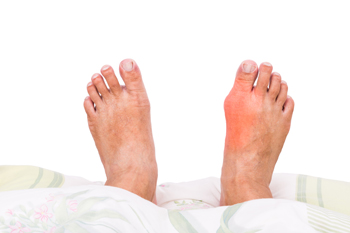 Bunions are bony bumps that form on the joint of your big toe. They cause your big toe to move towards the other toes and force the joint at the base of the big toe to stick out. If your bunions are causing you pain, there are several things that you can try to relieve the pain at home. Exercising your feet by performing stretches can strengthen your muscles and improve foot flexibility, which may ease your bunion pain. For a light foot exercise, stand on a towel and scrunch it up with your toes, or lift your toes off the floor for ten seconds while keeping your heels firmly on the ground. If your bunion is inflamed, applying ice to the affected area for several minutes may help reduce inflammation. If you are suffering from bunion pain, visiting a podiatrist who can offer you the most effective treatment options is highly recommended.
Bunions are bony bumps that form on the joint of your big toe. They cause your big toe to move towards the other toes and force the joint at the base of the big toe to stick out. If your bunions are causing you pain, there are several things that you can try to relieve the pain at home. Exercising your feet by performing stretches can strengthen your muscles and improve foot flexibility, which may ease your bunion pain. For a light foot exercise, stand on a towel and scrunch it up with your toes, or lift your toes off the floor for ten seconds while keeping your heels firmly on the ground. If your bunion is inflamed, applying ice to the affected area for several minutes may help reduce inflammation. If you are suffering from bunion pain, visiting a podiatrist who can offer you the most effective treatment options is highly recommended.
If you are suffering from bunions, contact one of our podiatrists of Pennsylvania. Our doctors can provide the care you need to keep you pain-free and on your feet.
What Is a Bunion?
A bunion is formed of swollen tissue or an enlargement of boney growth, usually located at the base joint of the toe that connects to the foot. The swelling occurs due to the bones in the big toe shifting inward, which impacts the other toes of the foot. This causes the area around the base of the big toe to become inflamed and painful.
Why Do Bunions Form?
Genetics – Susceptibility to bunions are often hereditary
Stress on the feet – Poorly fitted and uncomfortable footwear that places stress on feet, such as heels, can worsen existing bunions
How Are Bunions Diagnosed?
Doctors often perform two tests – blood tests and x-rays – when trying to diagnose bunions, especially in the early stages of development. Blood tests help determine if the foot pain is being caused by something else, such as arthritis, while x-rays provide a clear picture of your bone structure to your doctor.
How Are Bunions Treated?
- Refrain from wearing heels or similar shoes that cause discomfort
- Select wider shoes that can provide more comfort and reduce pain
- Anti-inflammatory and pain management drugs
- Orthotics or foot inserts
- Surgery
If you have any questions, please feel free to contact one of our offices located in Plymouth Meeting and Ambler, PA . We offer the newest diagnostic and treatment technologies for all your foot care needs.
Bunions
A bunion is an enlargement of the base joint of the toe that connects to the foot, often formed from a bony growth or a patch of swollen tissues. It is caused by the inward shifting of the bones in the big toe, toward the other toes of the foot. This shift can cause a serious amount of pain and discomfort. The area around the big toe can become inflamed, red, and painful.
Bunions are most commonly formed in people who are already genetically predisposed to them or other kinds of bone displacements. Existing bunions can be worsened by wearing improperly fitting shoes. Trying to cram your feet into high heels or running or walking in a way that causes too much stress on the feet can exacerbate bunion development. High heels not only push the big toe inward, but shift one's body weight and center of gravity towards the edge of the feet and toes, expediting bone displacement.
A podiatrist knowledgeable in foot structure and biomechanics will be able to quickly diagnose bunions. Bunions must be distinguished from gout or arthritic conditions, so blood tests may be necessary. The podiatrist may order a radiological exam to provide an image of the bone structure. If the x-ray demonstrates an enlargement of the joint near the base of the toe and a shifting toward the smaller toes, this is indicative of a bunion.
Wearing wider shoes can reduce pressure on the bunion and minimize pain, and high heeled shoes should be eliminated for a period of time. This may be enough to eliminate the pain associated with bunions; however, if pain persists, anti-inflammatory drugs may be prescribed. Severe pain may require an injection of steroids near the bunion. Orthotics for shoes may be prescribed which, by altering the pressure on the foot, can be helpful in reducing pain. These do not correct the problem; but by eliminating the pain, they can provide relief.
For cases that do not respond to these methods of treatment, surgery can be done to reposition the toe. A surgeon may do this by taking out a section of bone or by rearranging the ligaments and tendons in the toe to help keep it properly aligned. It may be necessary even after surgery to wear more comfortable shoes that avoid placing pressure on the toe, as the big toe may move back to its former orientation toward the smaller toes.
Preventing Cycling Injuries
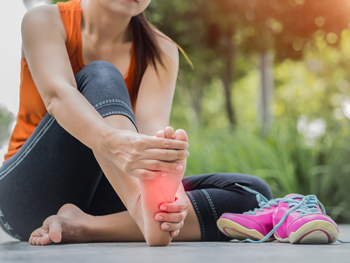 Cycling is becoming increasingly popular as a form of exercise. However, as a cyclist, you must be wary of injuries to your ankle or foot. Luckily, there are preventative measures that you can take to save yourself from the pain of an injury. One of the most common ankle injuries from cycling is Achilles tendonitis, an overuse injury of the tendon that runs from the calf muscle to the back of the foot. Training too much, or too hard too quickly, can increase your risk of Achilles tendonitis. To help prevent this injury, try to break up your cycling to allow adequate time for rest and healing. Another common problem among cyclists is foot numbness. This may be caused by ill-fitting shoes or a lot of uphill riding. To help prevent foot numbness, make sure that you are wearing properly-fitted shoes, and add more variety to your rides so that you are not always cycling uphill. For more information on how to prevent and treat cycling injuries of the feet and ankles, talk to a podiatrist today.
Cycling is becoming increasingly popular as a form of exercise. However, as a cyclist, you must be wary of injuries to your ankle or foot. Luckily, there are preventative measures that you can take to save yourself from the pain of an injury. One of the most common ankle injuries from cycling is Achilles tendonitis, an overuse injury of the tendon that runs from the calf muscle to the back of the foot. Training too much, or too hard too quickly, can increase your risk of Achilles tendonitis. To help prevent this injury, try to break up your cycling to allow adequate time for rest and healing. Another common problem among cyclists is foot numbness. This may be caused by ill-fitting shoes or a lot of uphill riding. To help prevent foot numbness, make sure that you are wearing properly-fitted shoes, and add more variety to your rides so that you are not always cycling uphill. For more information on how to prevent and treat cycling injuries of the feet and ankles, talk to a podiatrist today.
Sports related foot and ankle injuries require proper treatment before players can go back to their regular routines. For more information, contact one of our podiatrists of Pennsylvania. Our doctors can provide the care you need to keep you pain-free and on your feet.
Sports Related Foot and Ankle Injuries
Foot and ankle injuries are a common occurrence when it comes to athletes of any sport. While many athletes dismiss the initial aches and pains, the truth is that ignoring potential foot and ankle injuries can lead to serious problems. As athletes continue to place pressure and strain the area further, a mild injury can turn into something as serious as a rupture and may lead to a permanent disability. There are many factors that contribute to sports related foot and ankle injuries, which include failure to warm up properly, not providing support or wearing bad footwear. Common injuries and conditions athletes face, including:
- Plantar Fasciitis
- Plantar Fasciosis
- Achilles Tendinitis
- Achilles Tendon Rupture
- Ankle Sprains
Sports related injuries are commonly treated using the RICE method. This includes rest, applying ice to the injured area, compression and elevating the ankle. More serious sprains and injuries may require surgery, which could include arthroscopic and reconstructive surgery. Rehabilitation and therapy may also be required in order to get any recovering athlete to become fully functional again. Any unusual aches and pains an athlete sustains must be evaluated by a licensed, reputable medical professional.
If you have any questions please feel free to contact one of our offices located in Plymouth Meeting and Ambler, PA . We offer the newest diagnostic and treatment technologies for all your foot and ankle needs.

